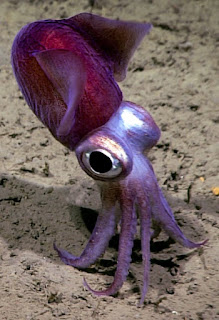Cloaking the Bobtail Squid
Going into the second half of 2022, my unregistered assault keyboard is clean and ready for action!
An idea in the Star Trek universe was the cloaking device, which made Klingon and Romulan spaceships invisible. The Hawaiian bobtail squid has a camouflaging method that can be likened to the Star Trek gadgets, and it was in place before the spaceship thing was a gleam in Gene Roddenberry's eye.
The little bobtail squid, which at first glance has a resemblance to an octopus, glows in the dark. It is not designed to do that by itself, but instead has help from bioluminescent bacteria. This win-win situation requires an amazing level of specified complexity.
 |
| Bobtail Squid about to get out of Dodge, NOAA Office of Ocean Exploration and Research (site endorsement not implied) |
Hawaiian bobtail squid (Euprymna scolopes) live among the sand flats and sea plants of the Hawaiian archipelago. Along with other bobtail squid, these lime-size ocean dwellers glow in the dark. The ability to glow in the dark has multiple purposes, including aiding the ability to find a mate.
Scientists spend whole careers trying to figure out how these squid lights work. Bioluminescent bacteria named Vibrio fischeri colonize unique light organs inside the squid’s bodies. The squid feed the bacteria, and the bacteria light up.
Simple, right? Well, it’s simple to look at but intricate in its setup and function. Bobtail squid light organs have lenses and reflectors to control light direction and intensity, filters to control light color, and expandable ink sacs to control light volume (illuminance). It needs all these parts to match its glow with the evershifting moon glow from above.
To finish reading this fascinating article, see "The Bobtail Squid’s Living Cloaking Device."